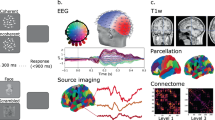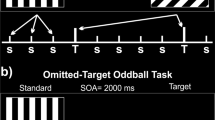Abstract
An fMRI-constrained source analysis was applied to investigate visual P300 in the Landolt ring task. To study the localization and relative activation timing of P300 generators, we implemented simultaneous EEG/fMRI to identify BOLD signal changes and record 64-channel EEG in 10 subjects during a Landolt ring task inside a 1.5-T fMRI scanner using an MR-compatible EEG recording system. MRI artifact subtraction software was applied to obtain continuous EEG data. Then, the simultaneous collecting of EEG and fMRI was validated in preserving relevant ERPs. The fMRI-constrained source analysis resulted in an 8-dipole solution. The bilateral middle frontal and the right inferior parietal dipole waveforms showed a short latency peak corresponding to the early P300 activity, while the four parietal and the anterior cingulate dipole waveforms showed a long latency peak corresponding to the late P300 activity. The longest latency peak of the anterior cingulate dipole agrees with its role in initiation of motor response after successful target recognition. Target detection in the Landolt ring task produces the strongest and most extensive parietal activation (especially superior parietal activation), which might be due to its particular visual attention switching.
Similar content being viewed by others
References
Picton T W. The P300 wave of the human event-related potential. J Clin Neurophysiol, 1992, 9: 456–479
Knight R T. Decreased response to novel stimuli after prefrontal lesions in man. Electroencephalogr Clin Neurophysiol, 1984, 59: 9–20
Knight R T. Contribution of human hippocampal region to novelty detection. Nature, 1996, 383: 256–259
Knight R T, Scabini D, Woods D L, et al. Contributions of temporal-parietal junction to the human auditory P300. Brain Res, 1989, 502: 109–116
Yamaguchi S, Knight R T. Effects of temporal-parietal lesions on the samatosensory P3 to lower limb stimulation. Electroencephalogr Clin Neurophysiol, 1992, 84: 139–148
Verleger R, Heide W, Butt C, et al. Reduction of P3b in patients with temporo-parietal lesions. Brain Res Cogn Brain Res, 1994, 2(2): 103–116
Baudena P, Halgren E, Heit G., et al. Intracerebral potentials to rare target and distractor auditory and visual stimuli. III. Frontal cortex. Electroencephalogr Clin Neurophysiol, 1995, 94(4): 251–264
Halgren E, Baudena P, Clarke J M, et al. Intracerebral potentials to rare target and distractor auditory and visual stimuli. I. Superior temporal plane and parietal lobe. Electroencephalogr Clin Neurophysiol, 1995, 94(3): 191–220
Halgren E, Baudena P, Clarke J M, et al. Intracerebral potentials to rare target and distractor auditory and visual stimuli. II. Medial, lateral and posterior temporal lobe. Electroencephalogr Clin Neurophysiol, 1995, 94(4): 229–250
Bledowski C, Prvulovic D, Goebel R, et al. Attentional systems in target and distractor processing: a combined ERP and fMRI study. NeuroImage, 2004, 22: 530–540
Bledowski C, Prvulovic D, Hoechstetter K, et al. Localizing P300 generators in visual target and distractor processing: A combined event-related potential and functional magnetic resonance imaging study. J Neurosci, 2004, 24(42): 9353–9360
Linden D E J, Prvulovic D, Formisano E, et al. The functional neuroanatomy of target detection: An fMRI study of visual and auditory oddball tasks. Cereb Cortex, 1999, 9: 815–823
Kiehl K A, Stevens M C, Laurens K R, et al. An adaptive reflexive processing model of neurocognitive function: supporting evidence from a large scale (n = 100) fMRI study of an auditory oddball task. Neuroimage, 2005, 25(3): 899–915
Eichele T, Specht K, Moosmann M, et al. Assessing the spatiotemporal evolution of neuronal activation with single-trial event-related potentials and functional MRI. Proc Natl Acad Sci USA, 2005, 102(49): 17798–17803
Corbetta M, Shulman G L. Control of goal directed and stimulus-driven attention in the brain. Nat Rev Neurosci, 2002, 3(3): 201–215
Hopfinger J B, Buonocore M H, Mangun G R. The neural mechanisms of top-down attentional control. Nat Neurosci, 2000, 3(3): 284–291
Allen P J, Josephs O, Turner R. A method for removing imaging artifact from continuous EEG recorded during functional MRI. NeuroImage, 2000, 12: 230–239
Laufs H, Kleinschmidt A, Beyerle A, et al. EEG-correlated fMRI of human alpha activity. NeuroImage, 2003, 19: 1463–1476
Hoffmann A, Jager L, Werhahn K J, et al. Electroencephalography during functional echo-planar imaging: Detection of epileptic spikes using post-processing methods. Magn Reson Med, 2000, 44: 791–798
Bonmassar G, Schwartz D P, Liu A K, et al. Spatiotemporal brain imaging of visual-evoked activity using interleaved EEG and fMRI recordings. NeuroImage, 2001, 13: 1035–1043
Liu A K, Belliveau J W, Dale A M. Spatiotemporal imaging of human brain activity using functional MRI constrained magnetoencephalography data: Monte Carlo simulations. Proc Natl Acad Sci USA, 1998, 95: 8945–8950
Li Y Z, Wang L Q, Wang M S. EEG-correlated fMRI of P3b component in P300 waves. Chin Sci Bull, 2005, 50(21): 2448–2456
Robson M D, Dorosz J L, Gore J C. Measurements of the temporal fMRI response of the human auditory cortex to trains of tones. Neuroimage, 1998, 7: 185–198
Stevens A A, Skudlarski P, Gatenby J C, et al. Event-related fMRI of auditory and visual oddball tasks. Magn Reson Imaging, 2000, 18: 495–502.
Friston K J, Holmes A P, Worsley K P, et al. Statistical parametric maps in functional imaging: A general linear approach. Hum Brain Map, 1995, 2: 189–210
Towle V L, Bolanos J, Suarez D, et al. The spatial location of EEG electrodes: Locating the best-fitting sphere relative to cortical anatomy. Electroencephalogr Clin Neurophysiol, 1993, 86: 1–6
Giard M H, Perrin F, Echallier J E, et al. Dissociation of temporal and frontal components in the human auditory N1 wave: A scalp current density and dipole model analysis. Electroencephalogr Clin Neurophysiol, 1994, 92: 238–252
Pantev C, Bertrand O, Eulitz C, et al. Specific tonotopic organizations of different areas of the human auditory cortex revealed by simultaneous magnetic and electric recordings. Electroencephalogr Clin Neurophysiol, 1995, 94: 26–40
Talariach J, Tournoux P. Co-planar Stereotaxic Atlas of the Human Brain. New York: Thieme Medical Publishes, 1988
Clark V, Hillyard S A. Spatial selective attention affects early extrastriate but not striate components of the visual evoked potential. J Cogn Neurosci, 1996, 8: 387–402
Lepage M, Ghaffar O, Nyberg L, et al. Prefrontal cortex and episodic memory retrieval mode. Proc Natl Acad Sci USA, 2000, 97: 506–511
Rushworth M F, Paus T, Sipila P K. Attention systems and the organization of the human parietal cortex. J Neurosci, 2001, 21: 5262–5271
Yantis S, Schwarzbach J, Serences J T, et al. Transient neural activity in human parietal cortex during spatial attention shifts. Nat Neurosci, 2002, 5: 995–1002
Pochon J B, Levy R, Poline J B, et al. The role of dorsolateral prefrontal cortex in the preparation of forthcoming actions: An fMRI study. Cereb Cortex, 2001, 11(3): 260–266
Sokolov E N, Clarke A D B, Stefan W, et al. Perception and the Conditioned Reflex. New York: The Macmillan Company, 1963
Jiang Y, Haxby J V, Martin A, et al. Complementary neural mechanisms for tracking items in human working memory. Science, 2000, 287: 643–646
Kok A. On the utility of P3 amplitude as a measure of processing capacity. Psychophysiology, 2001, 38: 557–577
Jeon Y W, Polich J. P3a from passive visual stimulus task. Clin Neurophysiol, 2001, 112: 2202–2208
Liddle P F, Kiehl K A, Smith A M. Event-related fMRI study of response inhibition. Hum Brain Mapp, 2001, 12(2): 100–109
Author information
Authors and Affiliations
Corresponding author
Additional information
Supported by the Natural Science Foundation of Guangdong Province (Grant No. 06028566)
About this article
Cite this article
Li, Y., Xu, T., Wang, L. et al. fMRI-constrained source analysis of visual P300 in Landolt ring task. Chin. Sci. Bull. 53, 76–86 (2008). https://doi.org/10.1007/s11434-008-0060-8
Received:
Accepted:
Issue Date:
DOI: https://doi.org/10.1007/s11434-008-0060-8




